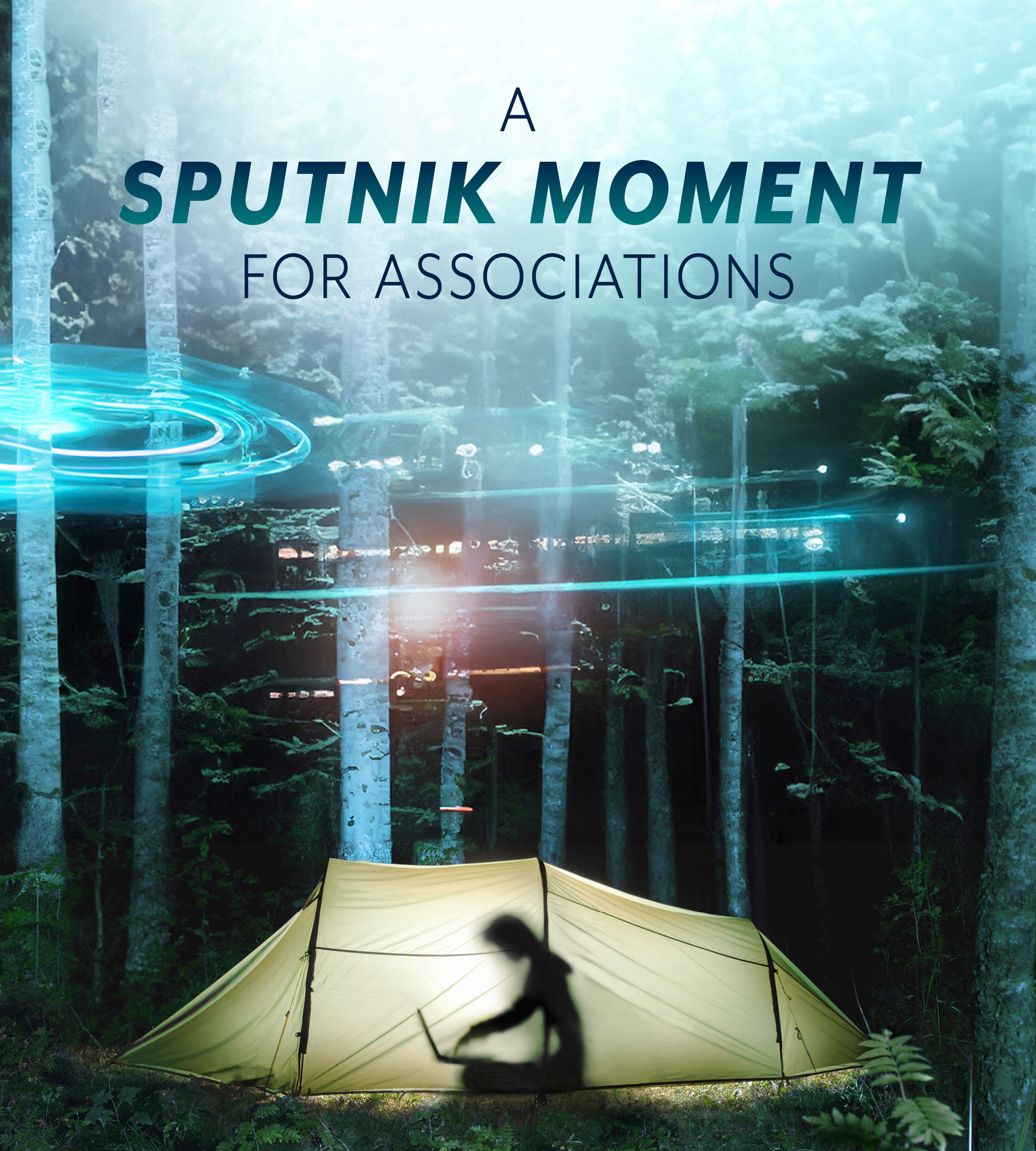Language
You can read the magazine in one of the following languages
The COVID-19 pandemic launched a new epoch for professional services associations, accelerating the transition of the workforce and member engagement from in-person to remote. Many associations are now on their heels.
It’s a ‘Sputnik’ moment, much like the way the Soviet Union’s satellite created a crisis of confidence in the United States in 1957. The Soviets were ahead, but it didn’t spell disaster because presidents Eisenhower and Kennedy invested in rallying the nation behind putting a man on the moon by 1969.
Like overtaking a global power in a space race, associations will require years-long, smart investments to transition from post-pandemic treading water to long-term thriving. The good news is that many associations recognize the problem.

The real solution is getting back to the basics of why associations exist in the first place – helping members perform more effectively.
The bad news is that many are also flailing – some are doubling down on in-person conferences while others are attempting to replace in-person conferences with webinars and downloadable resources. Still others are expanding benefits for expansion’s sake, providing services that add little value to members while consuming organizational resources.
But the real solution is getting back to the basics of why associations exist in the first place – helping members perform more effectively. Technology is neither a crutch nor a panacea – it is a tool, used effectively only on the right foundation. Association CEOs have to build that foundation with three strategic principles:
1. Unique value proposition (UVP). Why should members engage with your association?
2. Culture and wellbeing. How can you inspire the most passionate team to provide your UVP?
3. Financial sustainability. How can your team operationalize your UVP to create more margin to drive greater mission impact?
John F Kennedy’s 1961 exhortation for the federal government to put its resources behind the goal of landing on the moon by the end of the decade was an inspiration and a UVP for the entire nation. In the same vein, association CEOs have to ask themselves: What unique value can my organization provide that will be worth members’ dues and non-dues revenue, and how can that value be explained in a way that substantiates members’ decisions to make those investments?
This is not done by promising to provide all possible benefits, and then executing some of them poorly, with a diffuse staff merely scratching the value surface. Instead, associations must have a laser focus on the primary question from a member’s point of view: “What’s in it for me?”– or WIIFM.
That’s the strategy the American Society of Association Executives (ASAE) has used to ensure it’s adding value for members. In late 2021, the recently appointed president and CEO Michelle Mason wrote that the entire leadership team was assigned to “listen and be a lifeline for members whose career paths may have been interrupted or upended”.
This was the foundation for ASAE to introduce a three-year strategy grounded in deepening member engagement and strengthening the overall value proposition for its community.

Technology is neither a crutch nor a panacea – it is a tool, used effectively only on the right foundation.
While each association’s members will seek different value, I strongly recommend Clayton Christenson’s ‘Jobs to be Done’ framework to help leadership teams understand why their members are willing to pay for services or products, what members say they need versus what they don’t know they need, and how associations can address members’ unknown needs.
Information from members will help associations dive deep into their UVP and strip everything else down or out.
Sputnik moments don’t allow for mile-wide, inch-deep solutions. This is the time to reverse those dimensions and provide deep expertise and insights.
For example, ISACA is a technology credentialing organization with a straightforward UVP: tech training and credentialing to take tech employees and their organizations into the future. This is reinforced by their global membership and credentialing operations in more than 180 countries. Additionally, their website doesn’t vary from messaging this UVP.
From businesses to associations to entire countries, entities thrive when they are distinctive. The best way to close your doors and go out of business is to spend a lot of money offering many things that have little value.
Lyles Carr, Senior Vice President of The McCormick Group, has spent 50 years placing senior leaders into top nonprofits and other civic organizations. He told me that his company prioritizes recruiting and developing leaders “who have demonstrated purposeful leadership through the development of their organizational cultures and teams”.
It’s the same leadership principle that John F Kennedy invoked to put humans on the moon – not just by making a speech, but by guiding the effort, resources and mindsets needed to the inflation-adjusted tune of over US$288 billion in taxpayer money.
As Peter Drucker famously stated: “Culture eats strategy for breakfast.” That’s because when associations get their C-Suite executives on the same culture page, it sends a message throughout an entire organization.
Ray Gilmartin, Merck’s former CEO, shared with me: “The culture and values of an organization should be reinforced by senior leadership, that is, by the tone at the top and their actions. In addition, culture and values must be embraced consistently throughout the enterprise as middle managers and their teams get work done and solve problems.”

Having a passionate, hard-working, tech-savvy team likely means more value for new and future association members.
That means developing a human resources strategy to empower passionate team members to serve members more effectively. It also means incorporating technology where necessary as part of the culture conversation, because many team members may prefer to work from home instead of in an office.
Having a passionate, hard-working, tech-savvy team likely means more value for new and future association members. For example, the team will know when polished, professional-looking webinars can replace conferences – and how to drive home for members the importance of in-person experiences where pressing the flesh brings value, even in the high-tech, digital economy.
Evolving is a challenge for some organizations. When I started at the National Association of Corporate Directors (NACD) in 2010, long before the COVID-19 pandemic, its UVP was to help members develop long-term strategies that create economic change.
But we had become stagnant, resting on our laurels instead of applying that same UVP to ourselves. Then CEO Ken Daly thankfully recognized this, and told me – the new Head of Marketing – “We have great stories to tell. Let’s go tell those stories.”
Daly’s leadership on recognizing our UVP, building a great team to make it more impactful and communicating it with members was a game-changer. Revenue that had been stagnant for years skyrocketed from US$14 million in 2011 to nearly US$38 million in 2019, the year I left, as members rediscovered the WIIFM offered by NACD.
Today’s culture conversation is causing challenges for front-line workers to senior executives. But the principles of great culture are universal. Where people are located to conduct their work is about more than just a commute or wearing shorts instead of slacks – it’s about building a culture to create enormous value for associations and their members.
Many associations’ leaders are in the same dire place Eisenhower and Kennedy found themselves in decades ago. But every association CEO can become the Kennedy of their organization, inspiring members – in Kennedy’s case, taxpayers – to put their financial resources behind their association’s UVP.
For the United States, the space race’s value went far beyond landing a man on the moon – it set the stage for the Soviet Union’s collapse two decades later, resulting in America being the unquestioned world economic, democratic and technology leader.
The end goal of combining improved UVP and amazing culture is to create more satisfied, engaged members and to drive more consequential mission impact. As Edgility Consulting Co-Founder Christina Greenberg told me, it’s a constant struggle because associations are mission-oriented, not profit-centered – but they still must implement best practices in developing and managing their people and tracking the bottom line so they can build stronger teams and programs.

Evolving is a challenge for some organizations.
Associations won’t get there with a junk-food diet of tech jargon or by clinging to in-person conferences while webinars could be a wiser strategic priority. Instead, they’ll make more well-informed strategic decisions by determining what they can provide better than any other organization, and then building a team that passionately provides that value to members.
The payoff for members and stakeholders will be understanding what’s in it for them – and for associations, achieving more mission impact than ever before.

Henry Stoever
Contributor Collective Member
Henry Stoever is a Principal with the Brentwood Advisory Group. Previously he served as the President and CEO of the Association of Governing Boards of Universities and Colleges, as well as many marketing leadership roles with other organizations. For more information, go to https://brentwoodadvisory.com/
